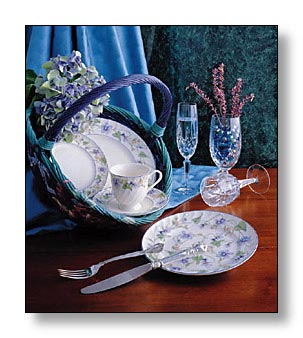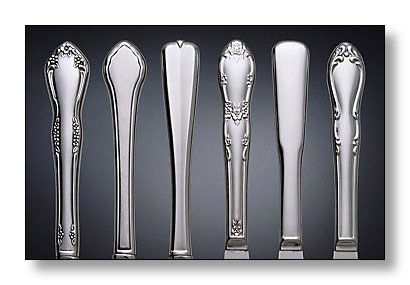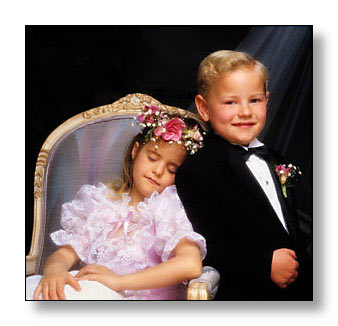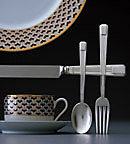
Dinnerware
...
You Need to Know.
When choosing patterns of tableware, you need to know basic terminology of classifications in each group-dinnerware, stemware, flatware and hollowware.
Earthenware - Made from less refined clays than china, it is low-fired which causes it to remain relatively soft and porous. Thus it is less durable than china or porcelain.
China - A ceramic made of white clay and pulverized stone, fired at a high temperature. It is thin, translucent,
resistant to chipping and/or breaking and will ring when tapped.
Bone China - In addition to china clays, this ceramic product contains a percentage of bone ash, giving it a characteristic whiteness.
Porcelain - A fine, hard, translucent material made from kaolin, quartz and feldspar and fired at high temperatures. It is translucent and hard.
Care of Dinnerware
Do not stack plates together or they may scratch. Invest in rubber racks designed to stand plates on their sides.
Rinse vinegar, lemon or salt at once form dishes that are decorated with gold, silver and colored over-glaze patterns.
Do not stack china when preparing it for washing to eliminate a lot of chipping and scratching.
Wash china in warm water. Avoid scouring pads and steel wool as they scratch glazes and ruin the decorations.
Use a soft brush to wash raised decoration, enamel, gold, silver or embossing.
Fine china, even with gold and platinum decorations, may be washed in the dishwasher . . . provided mild detergent is used.
A Listing of the Dinnerware Companies we represent:
| Aynsley |
Herend |
Portmeirion |
Royal Doulton |
|
Bernardaud |
Hutschenreuther |
PresenceTense |
Sango |
|
Christian Dior |
Lenox |
Raymaud
Porcelain |
Spode |
|
Dansk |
Lynn
Chase |
Richard
Ginori |
Swid Powell |
|
Denby |
Mikassa |
Royal China and Porcelain |
Villeroy and Boch |
|
Fabergé |
Nikko |
Royal Copenhagen |
Waterford |
|
Haviland |
Noritake |
Royal Crown Derby |
Zrike |

|
Stemware
...
Glass - Essentially a mixture of sand, potash, and lime or lead oxide which is then melted under high temperatures along with other ingredients to give it specific qualities of color, strength and refraction. Once melted, the molten glass is either molded or blown.
Crystal - To qualify as crystal, lead oxide is added
to the pot ash and soda.
Lead Crystal - Glass that contains at least 24% and up to 32% lead oxide. The lead imparts brilliance and is responsible for the bell-like tone that is produced when the piece is struck.
Care of Fine Stemware
Fine stemware, like all good things, deserves special care.
The following suggestions are offered and, when followed, are helpful in making fine glassware last longer.
1. Hand
Wash
a. Use moderately hot water and mild detergents.
b. A few drops of bluing in the water will add luster to the glass.
c. Add a water softener to both the wash and the rinse water.
d. Use a soft brush for washing cut or pressed patterns to get
down in the deep cuts.
e. Never wash or rinse gold or platinum-decorated glass in
scalding water or use strong soap, lest it loosen the decoration.
f. Present chipping by laying a towel or rubber mat in the sink
or dishpan.
g. Drain crystal on a rubber rack or on a towel.
h. The quicker glass is dried, the less chance there is of water spotting.
2. Automatic Dishwasher
a. Arrange carefully! Careless arrangement of crystal may
result in breakage.
b. Use mild detergent to prevent softening of gold or platinum trim.
c. Wait until glassware returns to room temperature, as wiping
glassware when it is hot may loosen gold or platinum decorations.
A listing of the stemware companies we
represent:
| Baccarat |
Dartington |
Marquis |
Svend Jensen |
| Ceska |
Lenox |
Stuart |
Waterford |


Flatware
... Sterling - The Queen of flatware, made of 925 parts of pure silver and 75 parts of an alloy.
Silverplate - Made from a base metal and electroplated with pure silver.
Stainless - Made from a steel alloy with chromium so as to inhibit corrosion and rust. The best quality stainless is marked "18/8", the ratio of chromium and nickel used to make the stainless.
Care of Flatware
The more it is used, the better it looks. Frequent use is the best way to keep sterling bright and beautiful.
Rotate pieces so each is used regularly.
Wash sterling in hot, soapy water, rinse thoroughly and dry.
If washed in a dishwasher, remove and dry immediately.
Temporary discoloration (caused by egg, mayonnaise, salt) can be removed by sponge and any liquid polish made for the purpose.
Avoid chemical dips and abrasives.
Polish occasionally with a good polish prepared especially for silver. Rub silver up and down in long horizontal strokes rather than in circles. Then wash in hot, soapy water, rinse and dry carefully.
A Listing of The Companies We Represent
| Gorham |
Lunt |
Reed and
Barton |
Wallace |
| Kirk
Stieff |
Oneida |
Towle |
Yamazaki |

|
Gift
Giving ... Whether your gift shopping is for a wedding, baby, graduation, birthday, holiday or perhaps to just say "I Love You", the gift gallery at
The Mulbray Gift Haus offers a wonderful selection of gifts that are sure to please. We have assembled a wide assortment of gifts priced from under $25 . . . Unique and quality gifts that will be remembered.

|

Etiquette
...
Some Fun and
Frequently Asked Questions:
1. When
entertaining, when does the host toast the guest of
honor?
2. What do you
do when the person next to you has just commandeered
your bread plate?
3. Do I pass
food to the right or the left?
4. If you are
at a dinner and are served something unidentifiable,
how do you find out what it is?
5. What do I do
if I knock something over or break something?
6. When olives
are served, how do I eat them?
7. When sitting
down at the table, do I enter from the right
or the left?
8. What is
etiquette concerning napkins?
9. What do I do
if wine is served during a meal and I don't
want to drink?
10. I'm not
certain about the etiquette of eating soup. Help!
The
Answers !
1. At the
beginning of the meal the host proposes a toast to
all the guests. Either during the meal or just
before the dessert, he proposes a toast to the guest
of honor, who in turn toasts the host during
dessert.
2. Do nothing.
Simply use the rim of your dinner plate for your
bread.
3. Food should
be passed to your right.
4. Say
something like, "I can't even guess what this
is, but it looks great. Can you
clue me in?" This is especially appropriate if
you are allergic to certain foods.
5. Stay cool ! Anyone
can have an accident. If you spill something, blot
up what you can. When necessary, your hostess should
quietly offer assistance. If you break something,
discreetly apologize, "I'm so sorry !"
Later offer to replace the item.
6. If the olive is
pitted, eat it whole. If it is large and not pitted,
hold it in your fingers and eat it in small bites.
As the pit passes the palm of your hand, deposit it
on the edge of your plate.
7. Be seated by
entering the chair from the left.
8. The hostess is
the first to move the napkin. Once placed on the lap
of the hostess, others follow suit. At the end of the
meal, the hostess places the napkin on the table to
signal that the meal is over, after everyone has
finished, of course. Place the napkin loosely on the
table to the left of your plate.
9. No
problem ! Just place your fingertips lightly on the
rim of the glass and say, "Thanks, but I'm not
having any this evening." Never turn your glass
upside down to indicate that you are not partaking.
10. Dip the
outer edge of the soup spoon into the soup rather
than the edge closest to you. Tilt the edge away
from you to diminish any dribble. Sip the soup from
the side of the spoon making no noise. It's fine to
tilt the bowl away from you to access the last of
the soup.
Stop
by either of our locations, visit with our
consultants and discover some great ideas to
personalize your table settings. A creative table
setting is the perfect complement to creative
entertaining.
|
|

![]()
![]()
![]()
![]()
![]() Dinnerware
Dinnerware![]() Stemware
Stemware![]() Flatware
Flatware![]() Gift
Giving
Gift
Giving![]() Etiquette
Etiquette![]() Contact Us
Contact Us


